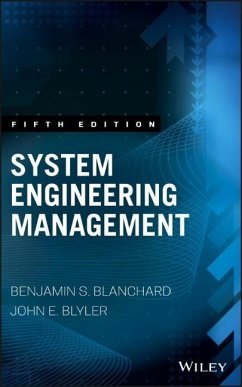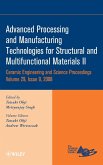- Gebundenes Buch
- Merkliste
- Auf die Merkliste
- Bewerten Bewerten
- Teilen
- Produkt teilen
- Produkterinnerung
- Produkterinnerung
A practical, step-by-step guide to total systems management Systems Engineering Management, Fifth Edition is a practical guide to the tools and methodologies used in the field. Using a "total systems management" approach, this book covers everything from initial establishment to system retirement, including design and development, testing, production, operations, maintenance, and support. This new edition has been fully updated to reflect the latest tools and best practices, and includes rich discussion on computer-based modeling and hardware and software systems integration. New case studies…mehr
Andere Kunden interessierten sich auch für
![Industrial Engineering and Production Management Industrial Engineering and Production Management]() Industrial Engineering and Production Management133,99 €
Industrial Engineering and Production Management133,99 €![Forecasting and Management of Technology Forecasting and Management of Technology]() Alan L PorterForecasting and Management of Technology164,99 €
Alan L PorterForecasting and Management of Technology164,99 €![Advanced Processing and Manufacturing Technologies for Structural and Multifunctional Materials II, Volume 29, Issue 9 Advanced Processing and Manufacturing Technologies for Structural and Multifunctional Materials II, Volume 29, Issue 9]() Advanced Processing and Manufacturing Technologies for Structural and Multifunctional Materials II, Volume 29, Issue 9123,99 €
Advanced Processing and Manufacturing Technologies for Structural and Multifunctional Materials II, Volume 29, Issue 9123,99 €![Advanced Processing and Manufacturing Technologies for Nanostructured and Multifunctional Materials III, Volume 37, Issue 5 Advanced Processing and Manufacturing Technologies for Nanostructured and Multifunctional Materials III, Volume 37, Issue 5]() Advanced Processing and Manufacturing Technologies for Nanostructured and Multifunctional Materials III, Volume 37, Issue 5266,99 €
Advanced Processing and Manufacturing Technologies for Nanostructured and Multifunctional Materials III, Volume 37, Issue 5266,99 €![Advanced Processing and Manufacturing Technologies for Structural and Multifunctional Materials VII, Volume 34, Issue 8 Advanced Processing and Manufacturing Technologies for Structural and Multifunctional Materials VII, Volume 34, Issue 8]() Advanced Processing and Manufacturing Technologies for Structural and Multifunctional Materials VII, Volume 34, Issue 8102,99 €
Advanced Processing and Manufacturing Technologies for Structural and Multifunctional Materials VII, Volume 34, Issue 8102,99 €![Integration of Ai-Based Manufacturing and Industrial Engineering Systems with the Internet of Things Integration of Ai-Based Manufacturing and Industrial Engineering Systems with the Internet of Things]() Integration of Ai-Based Manufacturing and Industrial Engineering Systems with the Internet of Things132,99 €
Integration of Ai-Based Manufacturing and Industrial Engineering Systems with the Internet of Things132,99 €![Open Resonator Microwave Sensor Systems for Industrial Gauging Open Resonator Microwave Sensor Systems for Industrial Gauging]() Nathan IdaOpen Resonator Microwave Sensor Systems for Industrial Gauging164,99 €
Nathan IdaOpen Resonator Microwave Sensor Systems for Industrial Gauging164,99 €-
-
-
A practical, step-by-step guide to total systems management Systems Engineering Management, Fifth Edition is a practical guide to the tools and methodologies used in the field. Using a "total systems management" approach, this book covers everything from initial establishment to system retirement, including design and development, testing, production, operations, maintenance, and support. This new edition has been fully updated to reflect the latest tools and best practices, and includes rich discussion on computer-based modeling and hardware and software systems integration. New case studies illustrate real-world application on both large- and small-scale systems in a variety of industries, and the companion website provides access to bonus case studies and helpful review checklists. The provided instructor's manual eases classroom integration, and updated end-of-chapter questions help reinforce the material. The challenges faced by system engineers are candidly addressed, with full guidance toward the tools they use daily to reduce costs and increase efficiency. System Engineering Management integrates industrial engineering, project management, and leadership skills into a unique emerging field. This book unifies these different skill sets into a single step-by-step approach that produces a well-rounded systems engineering management framework. * Learn the total systems lifecycle with real-world applications * Explore cutting edge design methods and technology * Integrate software and hardware systems for total SEM * Learn the critical IT principles that lead to robust systems Successful systems engineering managers must be capable of leading teams to produce systems that are robust, high-quality, supportable, cost effective, and responsive. Skilled, knowledgeable professionals are in demand across engineering fields, but also in industries as diverse as healthcare and communications. Systems Engineering Management, Fifth Edition provides practical, invaluable guidance for a nuanced field.
Hinweis: Dieser Artikel kann nur an eine deutsche Lieferadresse ausgeliefert werden.
Hinweis: Dieser Artikel kann nur an eine deutsche Lieferadresse ausgeliefert werden.
Produktdetails
- Produktdetails
- Verlag: John Wiley & Sons / Wiley
- Artikelnr. des Verlages: 1W119047820
- 5th Revised edition
- Seitenzahl: 576
- Erscheinungstermin: 29. Februar 2016
- Englisch
- Abmessung: 244mm x 161mm x 38mm
- Gewicht: 915g
- ISBN-13: 9781119047827
- ISBN-10: 111904782X
- Artikelnr.: 43000384
- Herstellerkennzeichnung
- Libri GmbH
- Europaallee 1
- 36244 Bad Hersfeld
- gpsr@libri.de
- Verlag: John Wiley & Sons / Wiley
- Artikelnr. des Verlages: 1W119047820
- 5th Revised edition
- Seitenzahl: 576
- Erscheinungstermin: 29. Februar 2016
- Englisch
- Abmessung: 244mm x 161mm x 38mm
- Gewicht: 915g
- ISBN-13: 9781119047827
- ISBN-10: 111904782X
- Artikelnr.: 43000384
- Herstellerkennzeichnung
- Libri GmbH
- Europaallee 1
- 36244 Bad Hersfeld
- gpsr@libri.de
BENJAMIN S. BLANCHARD is Professor Emeritus, Department of Industrial and Systems Engineering, Virginia Polytechnic Institute & State University. He serves as consultant in such fields as systems engineering, reliability, maintainability, and lifecycle costing. JOHN E. BLYLER is the founding advisor and affiliate professor of the Systems Engineering Graduate Program at Portland State University. He has considerable experience in hardware-software systems engineering and management, both in industry and government.
Preface xi
1 Introduction to System Engineering 1
1.1 Definition of a System 2
1.1.1 The Characteristics of a System 2
1.1.2 Categories of Systems 5
1.1.3 System of Systems (SOS) 8
1.2 The Current Environment: Some Challenges 9
1.3 The Need for System Engineering 15
1.3.1 The System Life Cycle 16
1.3.2 Definition of System Engineering 18
1.3.3 Requirements for System Engineering 25
1.3.4 System Architecture 26
1.3.5 System Science 26
1.3.6 System Analysis 27
1.3.7 Some Additional System Models 28
1.3.8 System Engineering in the Life Cycle (Some Applications) 32
1.4 Related Terms and Definitions 34
1.4.1 Concurrent/Simultaneous Engineering 35
1.4.2 Some Major Supporting Design Disciplines 36
1.4.3 Logistics and Supply-Chain Management (SCM) 38
1.4.4 Integrated System Maintenance and Support 40
1.4.5 Data and Information Management 43
1.4.6 Configuration Management (CM) 44
1.4.7 Total Quality Management (TQM) 45
1.4.8 Total System Value and Life-Cycle Cost (LCC) 45
1.4.9 Some Additional Terms And Definitions 46
1.5 System Engineering Management 47
1.6 Summary 51
Questions and Problems 51
2 The System Engineering Process 53
2.1 Definition of the Problem (Current Deficiency) 55
2.2 System Requirements (Needs Analysis) 56
2.3 System Feasibility Analysis 57
2.4 System Operational Requirements 59
2.5 The Logistics and Maintenance Support Concept 62
2.6 Identification and Prioritization of Technical Performance Measures
(TPMs) 69
2.7 Functional Analysis 74
2.7.1 Functional Flow Block Diagrams (FFBDs) 77
2.7.2 Operational Functions 80
2.7.3 Maintenance and Support Functions 80
2.7.4 Application of Functional Analysis 81
2.7.5 Interfaces with Other Systems in a SOS Configuration 88
2.8 Requirements Allocation 90
2.8.1 Functional Packaging and Partitioning 90
2.8.2 Allocation of System-Level Requirements to the Subsystem Level and
Below 92
2.8.3 Traceability of Requirements (Top-Down/Bottom-Up) 95
2.8.4 Allocation of Requirements in a SOS Configuration 95
2.9 System Synthesis, Analysis, and Design Optimization 97
2.10 Design Integration 105
2.11 System Test and Evaluation 108
2.11.1 Categories of Test and Evaluation 110
2.11.2 Integrated Test Planning 112
2.11.3 Preparation for Test and Evaluation 113
2.11.4 Test Performance, Data Collection, Analysis, and Validation 115
2.11.5 System Modifications 115
2.12 Production and/or Construction 117
2.13 System Operational Use and Sustaining Support 118
2.14 System Retirement and Material Recycling/Disposal 120
2.15 Summary 121
Questions and Problems 122
3 System Design Requirements 125
3.1 Development of Design Requirements and Design-To Criteria 128
3.2 Development of Specifications 129
3.3 The Integration of System Design Activities 135
3.4 Selected Design Engineering Disciplines 139
3.4.1 Software Engineering 139
3.4.2 Reliability Engineering 144
3.4.3 Maintainability Engineering 159
3.4.4 Human-Factors Engineering 174
3.4.5 Safety Engineering 185
3.4.6 Security Engineering 187
3.4.7 Manufacturing and Production Engineering 189
3.4.8 Logistics and Supportability Engineering 191
3.4.9 Disposability Engineering 199
3.4.10 Quality Engineering 200
3.4.11 Environmental Engineering 204
3.4.12 Value/Cost Engineering (Life-Cycle Costing) 207
3.5 SOS Integration and Interoperability Requirements 215
3.6 Summary 216
Questions and Problems 219
4 Engineering Design Methods and Tools 223
4.1 Conventional Design Practices 225
4.2 Analytical Methods 228
4.3 Information Technology, the Internet, and Emerging Technologies 229
4.4 Current Design Technologies and Tools 231
4.4.1 The Use of Simulation in System Engineering 235
4.4.2 The Use of Rapid Prototyping 235
4.4.3 The Use of Mock-Ups 236
4.5 Computer-Aided Design (CAD) 237
4.6 Computer-Aided Manufacturing (CAM) 245
4.7 Computer-Aided Support (CAS) 246
4.8 Summary 248
Questions and Problems 249
5 Design Review and Evaluation 251
5.1 Design Review and Evaluation Requirements 252
5.2 Informal Day-to-Day Review and Evaluation 256
5.3 Formal Design Reviews 262
5.3.1 Conceptual Design Review 264
5.3.2 System Design Reviews 265
5.3.3 Equipment/Software Design Reviews 266
5.3.4 Critical Design Review 267
5.4 The Design Change and System Modification Process 269
5.5 Supplier Review and Evaluation 272
5.6 Summary 274
Questions and Problems 274
6 System Engineering Program Planning 275
6.1 System Engineering Program Requirements 278
6.1.1 The Need for Early System Planning 278
6.1.2 Determination of Program Requirements 280
6.2 System Engineering Management Plan (SEMP) 282
6.2.1 Statement of Work 285
6.2.2 Definition of System Engineering Functions and Tasks 286
6.2.3 System Engineering Organization 293
6.2.4 Development of a Work Breakdown Structure (wbs) 296
6.2.5 Specification/Documentation Tree 303
6.2.6 Technical Performance Measures (TPM) 309
6.2.7 Development of Program Schedules 310
6.2.8 Preparation of Cost Projections 324
6.2.9 Program Technical Reviews and Audits 328
6.2.10 Program Reporting Requirements 329
6.3 Determination of Outsourcing Requirements 332
6.3.1 Identification of Potential Suppliers 334
6.3.2 Development of a Request for Proposal (RFP) 336
6.3.3 Review and Evaluation of Supplier Proposals 337
6.3.4 Selection of Suppliers and Contract Negotiation 344
6.3.5 Supplier Monitoring and Control 351
6.4 Integration of Design Specialty Plans 353
6.5 Interfaces with Other Program Activities 355
6.5.1 Interface Management 359
6.6 Management Methods/Tools 360
6.7 Risk Management Plan 361
6.8 Global Applications/Relationships 366
6.9 Summary 367
Questions and Problems 369
7 Organization for System Engineering 372
7.1 Developing the Organizational Structure 373
7.2 Customer, Producer, and Supplier Relationships 374
7.3 Customer Organization and Functions 376
7.4 Producer Organization and Functions (the Contractor) 378
7.4.1 Functional Organization Structure 379
7.4.2 Product-Line/Project Organization Structure 383
7.4.3 Matrix Organizational Structure 384
7.4.4 Integrated Product and Process Development (IPPD) 387
7.4.5 Integrated Product/Process Teams (IPTs) 389
7.4.6 System Engineering Organization 390
7.5 Tailoring the Process 396
7.5.1 Tailoring the Process 400
7.5.2 Middle-Out Approach 401
7.5.3 Managing from the Middle 404
7.6 Supplier Organization and Functions 406
7.6.1 Mapping Organization and Systems Structures 409
7.7 Human Resource Requirements 411
7.7.1 Creating the Proper Organizational Environment 411
7.7.2 Leadership Characteristics 414
7.7.3 The Needs of the Individual 415
7.7.4 Staffing the Organization 419
7.7.5 Personnel Development and Training 421
7.8 Summary 423
Questions and Problems 424
8 System Engineering Program Evaluation 426
8.1 Evaluation Requirements 428
8.2 Benchmarking 428
8.3 Evaluation of the System Engineering Organization 431
8.4 Program Reporting, Feedback, and Control 437
8.5 Summary 438
Questions and Problems 439
Appendix A Functional Analysis (Case-Study Examples) 440
Appendix B Cost Process and Models 447
Appendix c Selected Case Studies (Nine Examples) 481
Appendix d Design Review Checklist 529
Appendix E Supplier Evaluation Checklist 530
Appendix F Selected Bibliography 531
Index 539
1 Introduction to System Engineering 1
1.1 Definition of a System 2
1.1.1 The Characteristics of a System 2
1.1.2 Categories of Systems 5
1.1.3 System of Systems (SOS) 8
1.2 The Current Environment: Some Challenges 9
1.3 The Need for System Engineering 15
1.3.1 The System Life Cycle 16
1.3.2 Definition of System Engineering 18
1.3.3 Requirements for System Engineering 25
1.3.4 System Architecture 26
1.3.5 System Science 26
1.3.6 System Analysis 27
1.3.7 Some Additional System Models 28
1.3.8 System Engineering in the Life Cycle (Some Applications) 32
1.4 Related Terms and Definitions 34
1.4.1 Concurrent/Simultaneous Engineering 35
1.4.2 Some Major Supporting Design Disciplines 36
1.4.3 Logistics and Supply-Chain Management (SCM) 38
1.4.4 Integrated System Maintenance and Support 40
1.4.5 Data and Information Management 43
1.4.6 Configuration Management (CM) 44
1.4.7 Total Quality Management (TQM) 45
1.4.8 Total System Value and Life-Cycle Cost (LCC) 45
1.4.9 Some Additional Terms And Definitions 46
1.5 System Engineering Management 47
1.6 Summary 51
Questions and Problems 51
2 The System Engineering Process 53
2.1 Definition of the Problem (Current Deficiency) 55
2.2 System Requirements (Needs Analysis) 56
2.3 System Feasibility Analysis 57
2.4 System Operational Requirements 59
2.5 The Logistics and Maintenance Support Concept 62
2.6 Identification and Prioritization of Technical Performance Measures
(TPMs) 69
2.7 Functional Analysis 74
2.7.1 Functional Flow Block Diagrams (FFBDs) 77
2.7.2 Operational Functions 80
2.7.3 Maintenance and Support Functions 80
2.7.4 Application of Functional Analysis 81
2.7.5 Interfaces with Other Systems in a SOS Configuration 88
2.8 Requirements Allocation 90
2.8.1 Functional Packaging and Partitioning 90
2.8.2 Allocation of System-Level Requirements to the Subsystem Level and
Below 92
2.8.3 Traceability of Requirements (Top-Down/Bottom-Up) 95
2.8.4 Allocation of Requirements in a SOS Configuration 95
2.9 System Synthesis, Analysis, and Design Optimization 97
2.10 Design Integration 105
2.11 System Test and Evaluation 108
2.11.1 Categories of Test and Evaluation 110
2.11.2 Integrated Test Planning 112
2.11.3 Preparation for Test and Evaluation 113
2.11.4 Test Performance, Data Collection, Analysis, and Validation 115
2.11.5 System Modifications 115
2.12 Production and/or Construction 117
2.13 System Operational Use and Sustaining Support 118
2.14 System Retirement and Material Recycling/Disposal 120
2.15 Summary 121
Questions and Problems 122
3 System Design Requirements 125
3.1 Development of Design Requirements and Design-To Criteria 128
3.2 Development of Specifications 129
3.3 The Integration of System Design Activities 135
3.4 Selected Design Engineering Disciplines 139
3.4.1 Software Engineering 139
3.4.2 Reliability Engineering 144
3.4.3 Maintainability Engineering 159
3.4.4 Human-Factors Engineering 174
3.4.5 Safety Engineering 185
3.4.6 Security Engineering 187
3.4.7 Manufacturing and Production Engineering 189
3.4.8 Logistics and Supportability Engineering 191
3.4.9 Disposability Engineering 199
3.4.10 Quality Engineering 200
3.4.11 Environmental Engineering 204
3.4.12 Value/Cost Engineering (Life-Cycle Costing) 207
3.5 SOS Integration and Interoperability Requirements 215
3.6 Summary 216
Questions and Problems 219
4 Engineering Design Methods and Tools 223
4.1 Conventional Design Practices 225
4.2 Analytical Methods 228
4.3 Information Technology, the Internet, and Emerging Technologies 229
4.4 Current Design Technologies and Tools 231
4.4.1 The Use of Simulation in System Engineering 235
4.4.2 The Use of Rapid Prototyping 235
4.4.3 The Use of Mock-Ups 236
4.5 Computer-Aided Design (CAD) 237
4.6 Computer-Aided Manufacturing (CAM) 245
4.7 Computer-Aided Support (CAS) 246
4.8 Summary 248
Questions and Problems 249
5 Design Review and Evaluation 251
5.1 Design Review and Evaluation Requirements 252
5.2 Informal Day-to-Day Review and Evaluation 256
5.3 Formal Design Reviews 262
5.3.1 Conceptual Design Review 264
5.3.2 System Design Reviews 265
5.3.3 Equipment/Software Design Reviews 266
5.3.4 Critical Design Review 267
5.4 The Design Change and System Modification Process 269
5.5 Supplier Review and Evaluation 272
5.6 Summary 274
Questions and Problems 274
6 System Engineering Program Planning 275
6.1 System Engineering Program Requirements 278
6.1.1 The Need for Early System Planning 278
6.1.2 Determination of Program Requirements 280
6.2 System Engineering Management Plan (SEMP) 282
6.2.1 Statement of Work 285
6.2.2 Definition of System Engineering Functions and Tasks 286
6.2.3 System Engineering Organization 293
6.2.4 Development of a Work Breakdown Structure (wbs) 296
6.2.5 Specification/Documentation Tree 303
6.2.6 Technical Performance Measures (TPM) 309
6.2.7 Development of Program Schedules 310
6.2.8 Preparation of Cost Projections 324
6.2.9 Program Technical Reviews and Audits 328
6.2.10 Program Reporting Requirements 329
6.3 Determination of Outsourcing Requirements 332
6.3.1 Identification of Potential Suppliers 334
6.3.2 Development of a Request for Proposal (RFP) 336
6.3.3 Review and Evaluation of Supplier Proposals 337
6.3.4 Selection of Suppliers and Contract Negotiation 344
6.3.5 Supplier Monitoring and Control 351
6.4 Integration of Design Specialty Plans 353
6.5 Interfaces with Other Program Activities 355
6.5.1 Interface Management 359
6.6 Management Methods/Tools 360
6.7 Risk Management Plan 361
6.8 Global Applications/Relationships 366
6.9 Summary 367
Questions and Problems 369
7 Organization for System Engineering 372
7.1 Developing the Organizational Structure 373
7.2 Customer, Producer, and Supplier Relationships 374
7.3 Customer Organization and Functions 376
7.4 Producer Organization and Functions (the Contractor) 378
7.4.1 Functional Organization Structure 379
7.4.2 Product-Line/Project Organization Structure 383
7.4.3 Matrix Organizational Structure 384
7.4.4 Integrated Product and Process Development (IPPD) 387
7.4.5 Integrated Product/Process Teams (IPTs) 389
7.4.6 System Engineering Organization 390
7.5 Tailoring the Process 396
7.5.1 Tailoring the Process 400
7.5.2 Middle-Out Approach 401
7.5.3 Managing from the Middle 404
7.6 Supplier Organization and Functions 406
7.6.1 Mapping Organization and Systems Structures 409
7.7 Human Resource Requirements 411
7.7.1 Creating the Proper Organizational Environment 411
7.7.2 Leadership Characteristics 414
7.7.3 The Needs of the Individual 415
7.7.4 Staffing the Organization 419
7.7.5 Personnel Development and Training 421
7.8 Summary 423
Questions and Problems 424
8 System Engineering Program Evaluation 426
8.1 Evaluation Requirements 428
8.2 Benchmarking 428
8.3 Evaluation of the System Engineering Organization 431
8.4 Program Reporting, Feedback, and Control 437
8.5 Summary 438
Questions and Problems 439
Appendix A Functional Analysis (Case-Study Examples) 440
Appendix B Cost Process and Models 447
Appendix c Selected Case Studies (Nine Examples) 481
Appendix d Design Review Checklist 529
Appendix E Supplier Evaluation Checklist 530
Appendix F Selected Bibliography 531
Index 539
Preface xi
1 Introduction to System Engineering 1
1.1 Definition of a System 2
1.1.1 The Characteristics of a System 2
1.1.2 Categories of Systems 5
1.1.3 System of Systems (SOS) 8
1.2 The Current Environment: Some Challenges 9
1.3 The Need for System Engineering 15
1.3.1 The System Life Cycle 16
1.3.2 Definition of System Engineering 18
1.3.3 Requirements for System Engineering 25
1.3.4 System Architecture 26
1.3.5 System Science 26
1.3.6 System Analysis 27
1.3.7 Some Additional System Models 28
1.3.8 System Engineering in the Life Cycle (Some Applications) 32
1.4 Related Terms and Definitions 34
1.4.1 Concurrent/Simultaneous Engineering 35
1.4.2 Some Major Supporting Design Disciplines 36
1.4.3 Logistics and Supply-Chain Management (SCM) 38
1.4.4 Integrated System Maintenance and Support 40
1.4.5 Data and Information Management 43
1.4.6 Configuration Management (CM) 44
1.4.7 Total Quality Management (TQM) 45
1.4.8 Total System Value and Life-Cycle Cost (LCC) 45
1.4.9 Some Additional Terms And Definitions 46
1.5 System Engineering Management 47
1.6 Summary 51
Questions and Problems 51
2 The System Engineering Process 53
2.1 Definition of the Problem (Current Deficiency) 55
2.2 System Requirements (Needs Analysis) 56
2.3 System Feasibility Analysis 57
2.4 System Operational Requirements 59
2.5 The Logistics and Maintenance Support Concept 62
2.6 Identification and Prioritization of Technical Performance Measures
(TPMs) 69
2.7 Functional Analysis 74
2.7.1 Functional Flow Block Diagrams (FFBDs) 77
2.7.2 Operational Functions 80
2.7.3 Maintenance and Support Functions 80
2.7.4 Application of Functional Analysis 81
2.7.5 Interfaces with Other Systems in a SOS Configuration 88
2.8 Requirements Allocation 90
2.8.1 Functional Packaging and Partitioning 90
2.8.2 Allocation of System-Level Requirements to the Subsystem Level and
Below 92
2.8.3 Traceability of Requirements (Top-Down/Bottom-Up) 95
2.8.4 Allocation of Requirements in a SOS Configuration 95
2.9 System Synthesis, Analysis, and Design Optimization 97
2.10 Design Integration 105
2.11 System Test and Evaluation 108
2.11.1 Categories of Test and Evaluation 110
2.11.2 Integrated Test Planning 112
2.11.3 Preparation for Test and Evaluation 113
2.11.4 Test Performance, Data Collection, Analysis, and Validation 115
2.11.5 System Modifications 115
2.12 Production and/or Construction 117
2.13 System Operational Use and Sustaining Support 118
2.14 System Retirement and Material Recycling/Disposal 120
2.15 Summary 121
Questions and Problems 122
3 System Design Requirements 125
3.1 Development of Design Requirements and Design-To Criteria 128
3.2 Development of Specifications 129
3.3 The Integration of System Design Activities 135
3.4 Selected Design Engineering Disciplines 139
3.4.1 Software Engineering 139
3.4.2 Reliability Engineering 144
3.4.3 Maintainability Engineering 159
3.4.4 Human-Factors Engineering 174
3.4.5 Safety Engineering 185
3.4.6 Security Engineering 187
3.4.7 Manufacturing and Production Engineering 189
3.4.8 Logistics and Supportability Engineering 191
3.4.9 Disposability Engineering 199
3.4.10 Quality Engineering 200
3.4.11 Environmental Engineering 204
3.4.12 Value/Cost Engineering (Life-Cycle Costing) 207
3.5 SOS Integration and Interoperability Requirements 215
3.6 Summary 216
Questions and Problems 219
4 Engineering Design Methods and Tools 223
4.1 Conventional Design Practices 225
4.2 Analytical Methods 228
4.3 Information Technology, the Internet, and Emerging Technologies 229
4.4 Current Design Technologies and Tools 231
4.4.1 The Use of Simulation in System Engineering 235
4.4.2 The Use of Rapid Prototyping 235
4.4.3 The Use of Mock-Ups 236
4.5 Computer-Aided Design (CAD) 237
4.6 Computer-Aided Manufacturing (CAM) 245
4.7 Computer-Aided Support (CAS) 246
4.8 Summary 248
Questions and Problems 249
5 Design Review and Evaluation 251
5.1 Design Review and Evaluation Requirements 252
5.2 Informal Day-to-Day Review and Evaluation 256
5.3 Formal Design Reviews 262
5.3.1 Conceptual Design Review 264
5.3.2 System Design Reviews 265
5.3.3 Equipment/Software Design Reviews 266
5.3.4 Critical Design Review 267
5.4 The Design Change and System Modification Process 269
5.5 Supplier Review and Evaluation 272
5.6 Summary 274
Questions and Problems 274
6 System Engineering Program Planning 275
6.1 System Engineering Program Requirements 278
6.1.1 The Need for Early System Planning 278
6.1.2 Determination of Program Requirements 280
6.2 System Engineering Management Plan (SEMP) 282
6.2.1 Statement of Work 285
6.2.2 Definition of System Engineering Functions and Tasks 286
6.2.3 System Engineering Organization 293
6.2.4 Development of a Work Breakdown Structure (wbs) 296
6.2.5 Specification/Documentation Tree 303
6.2.6 Technical Performance Measures (TPM) 309
6.2.7 Development of Program Schedules 310
6.2.8 Preparation of Cost Projections 324
6.2.9 Program Technical Reviews and Audits 328
6.2.10 Program Reporting Requirements 329
6.3 Determination of Outsourcing Requirements 332
6.3.1 Identification of Potential Suppliers 334
6.3.2 Development of a Request for Proposal (RFP) 336
6.3.3 Review and Evaluation of Supplier Proposals 337
6.3.4 Selection of Suppliers and Contract Negotiation 344
6.3.5 Supplier Monitoring and Control 351
6.4 Integration of Design Specialty Plans 353
6.5 Interfaces with Other Program Activities 355
6.5.1 Interface Management 359
6.6 Management Methods/Tools 360
6.7 Risk Management Plan 361
6.8 Global Applications/Relationships 366
6.9 Summary 367
Questions and Problems 369
7 Organization for System Engineering 372
7.1 Developing the Organizational Structure 373
7.2 Customer, Producer, and Supplier Relationships 374
7.3 Customer Organization and Functions 376
7.4 Producer Organization and Functions (the Contractor) 378
7.4.1 Functional Organization Structure 379
7.4.2 Product-Line/Project Organization Structure 383
7.4.3 Matrix Organizational Structure 384
7.4.4 Integrated Product and Process Development (IPPD) 387
7.4.5 Integrated Product/Process Teams (IPTs) 389
7.4.6 System Engineering Organization 390
7.5 Tailoring the Process 396
7.5.1 Tailoring the Process 400
7.5.2 Middle-Out Approach 401
7.5.3 Managing from the Middle 404
7.6 Supplier Organization and Functions 406
7.6.1 Mapping Organization and Systems Structures 409
7.7 Human Resource Requirements 411
7.7.1 Creating the Proper Organizational Environment 411
7.7.2 Leadership Characteristics 414
7.7.3 The Needs of the Individual 415
7.7.4 Staffing the Organization 419
7.7.5 Personnel Development and Training 421
7.8 Summary 423
Questions and Problems 424
8 System Engineering Program Evaluation 426
8.1 Evaluation Requirements 428
8.2 Benchmarking 428
8.3 Evaluation of the System Engineering Organization 431
8.4 Program Reporting, Feedback, and Control 437
8.5 Summary 438
Questions and Problems 439
Appendix A Functional Analysis (Case-Study Examples) 440
Appendix B Cost Process and Models 447
Appendix c Selected Case Studies (Nine Examples) 481
Appendix d Design Review Checklist 529
Appendix E Supplier Evaluation Checklist 530
Appendix F Selected Bibliography 531
Index 539
1 Introduction to System Engineering 1
1.1 Definition of a System 2
1.1.1 The Characteristics of a System 2
1.1.2 Categories of Systems 5
1.1.3 System of Systems (SOS) 8
1.2 The Current Environment: Some Challenges 9
1.3 The Need for System Engineering 15
1.3.1 The System Life Cycle 16
1.3.2 Definition of System Engineering 18
1.3.3 Requirements for System Engineering 25
1.3.4 System Architecture 26
1.3.5 System Science 26
1.3.6 System Analysis 27
1.3.7 Some Additional System Models 28
1.3.8 System Engineering in the Life Cycle (Some Applications) 32
1.4 Related Terms and Definitions 34
1.4.1 Concurrent/Simultaneous Engineering 35
1.4.2 Some Major Supporting Design Disciplines 36
1.4.3 Logistics and Supply-Chain Management (SCM) 38
1.4.4 Integrated System Maintenance and Support 40
1.4.5 Data and Information Management 43
1.4.6 Configuration Management (CM) 44
1.4.7 Total Quality Management (TQM) 45
1.4.8 Total System Value and Life-Cycle Cost (LCC) 45
1.4.9 Some Additional Terms And Definitions 46
1.5 System Engineering Management 47
1.6 Summary 51
Questions and Problems 51
2 The System Engineering Process 53
2.1 Definition of the Problem (Current Deficiency) 55
2.2 System Requirements (Needs Analysis) 56
2.3 System Feasibility Analysis 57
2.4 System Operational Requirements 59
2.5 The Logistics and Maintenance Support Concept 62
2.6 Identification and Prioritization of Technical Performance Measures
(TPMs) 69
2.7 Functional Analysis 74
2.7.1 Functional Flow Block Diagrams (FFBDs) 77
2.7.2 Operational Functions 80
2.7.3 Maintenance and Support Functions 80
2.7.4 Application of Functional Analysis 81
2.7.5 Interfaces with Other Systems in a SOS Configuration 88
2.8 Requirements Allocation 90
2.8.1 Functional Packaging and Partitioning 90
2.8.2 Allocation of System-Level Requirements to the Subsystem Level and
Below 92
2.8.3 Traceability of Requirements (Top-Down/Bottom-Up) 95
2.8.4 Allocation of Requirements in a SOS Configuration 95
2.9 System Synthesis, Analysis, and Design Optimization 97
2.10 Design Integration 105
2.11 System Test and Evaluation 108
2.11.1 Categories of Test and Evaluation 110
2.11.2 Integrated Test Planning 112
2.11.3 Preparation for Test and Evaluation 113
2.11.4 Test Performance, Data Collection, Analysis, and Validation 115
2.11.5 System Modifications 115
2.12 Production and/or Construction 117
2.13 System Operational Use and Sustaining Support 118
2.14 System Retirement and Material Recycling/Disposal 120
2.15 Summary 121
Questions and Problems 122
3 System Design Requirements 125
3.1 Development of Design Requirements and Design-To Criteria 128
3.2 Development of Specifications 129
3.3 The Integration of System Design Activities 135
3.4 Selected Design Engineering Disciplines 139
3.4.1 Software Engineering 139
3.4.2 Reliability Engineering 144
3.4.3 Maintainability Engineering 159
3.4.4 Human-Factors Engineering 174
3.4.5 Safety Engineering 185
3.4.6 Security Engineering 187
3.4.7 Manufacturing and Production Engineering 189
3.4.8 Logistics and Supportability Engineering 191
3.4.9 Disposability Engineering 199
3.4.10 Quality Engineering 200
3.4.11 Environmental Engineering 204
3.4.12 Value/Cost Engineering (Life-Cycle Costing) 207
3.5 SOS Integration and Interoperability Requirements 215
3.6 Summary 216
Questions and Problems 219
4 Engineering Design Methods and Tools 223
4.1 Conventional Design Practices 225
4.2 Analytical Methods 228
4.3 Information Technology, the Internet, and Emerging Technologies 229
4.4 Current Design Technologies and Tools 231
4.4.1 The Use of Simulation in System Engineering 235
4.4.2 The Use of Rapid Prototyping 235
4.4.3 The Use of Mock-Ups 236
4.5 Computer-Aided Design (CAD) 237
4.6 Computer-Aided Manufacturing (CAM) 245
4.7 Computer-Aided Support (CAS) 246
4.8 Summary 248
Questions and Problems 249
5 Design Review and Evaluation 251
5.1 Design Review and Evaluation Requirements 252
5.2 Informal Day-to-Day Review and Evaluation 256
5.3 Formal Design Reviews 262
5.3.1 Conceptual Design Review 264
5.3.2 System Design Reviews 265
5.3.3 Equipment/Software Design Reviews 266
5.3.4 Critical Design Review 267
5.4 The Design Change and System Modification Process 269
5.5 Supplier Review and Evaluation 272
5.6 Summary 274
Questions and Problems 274
6 System Engineering Program Planning 275
6.1 System Engineering Program Requirements 278
6.1.1 The Need for Early System Planning 278
6.1.2 Determination of Program Requirements 280
6.2 System Engineering Management Plan (SEMP) 282
6.2.1 Statement of Work 285
6.2.2 Definition of System Engineering Functions and Tasks 286
6.2.3 System Engineering Organization 293
6.2.4 Development of a Work Breakdown Structure (wbs) 296
6.2.5 Specification/Documentation Tree 303
6.2.6 Technical Performance Measures (TPM) 309
6.2.7 Development of Program Schedules 310
6.2.8 Preparation of Cost Projections 324
6.2.9 Program Technical Reviews and Audits 328
6.2.10 Program Reporting Requirements 329
6.3 Determination of Outsourcing Requirements 332
6.3.1 Identification of Potential Suppliers 334
6.3.2 Development of a Request for Proposal (RFP) 336
6.3.3 Review and Evaluation of Supplier Proposals 337
6.3.4 Selection of Suppliers and Contract Negotiation 344
6.3.5 Supplier Monitoring and Control 351
6.4 Integration of Design Specialty Plans 353
6.5 Interfaces with Other Program Activities 355
6.5.1 Interface Management 359
6.6 Management Methods/Tools 360
6.7 Risk Management Plan 361
6.8 Global Applications/Relationships 366
6.9 Summary 367
Questions and Problems 369
7 Organization for System Engineering 372
7.1 Developing the Organizational Structure 373
7.2 Customer, Producer, and Supplier Relationships 374
7.3 Customer Organization and Functions 376
7.4 Producer Organization and Functions (the Contractor) 378
7.4.1 Functional Organization Structure 379
7.4.2 Product-Line/Project Organization Structure 383
7.4.3 Matrix Organizational Structure 384
7.4.4 Integrated Product and Process Development (IPPD) 387
7.4.5 Integrated Product/Process Teams (IPTs) 389
7.4.6 System Engineering Organization 390
7.5 Tailoring the Process 396
7.5.1 Tailoring the Process 400
7.5.2 Middle-Out Approach 401
7.5.3 Managing from the Middle 404
7.6 Supplier Organization and Functions 406
7.6.1 Mapping Organization and Systems Structures 409
7.7 Human Resource Requirements 411
7.7.1 Creating the Proper Organizational Environment 411
7.7.2 Leadership Characteristics 414
7.7.3 The Needs of the Individual 415
7.7.4 Staffing the Organization 419
7.7.5 Personnel Development and Training 421
7.8 Summary 423
Questions and Problems 424
8 System Engineering Program Evaluation 426
8.1 Evaluation Requirements 428
8.2 Benchmarking 428
8.3 Evaluation of the System Engineering Organization 431
8.4 Program Reporting, Feedback, and Control 437
8.5 Summary 438
Questions and Problems 439
Appendix A Functional Analysis (Case-Study Examples) 440
Appendix B Cost Process and Models 447
Appendix c Selected Case Studies (Nine Examples) 481
Appendix d Design Review Checklist 529
Appendix E Supplier Evaluation Checklist 530
Appendix F Selected Bibliography 531
Index 539








